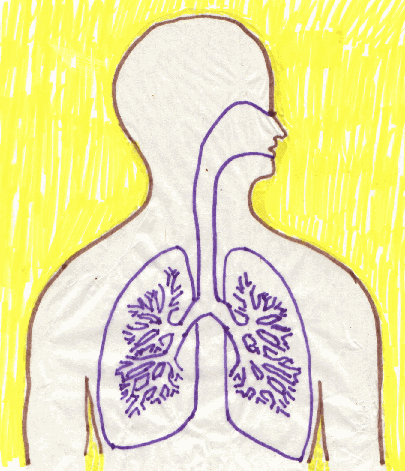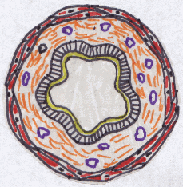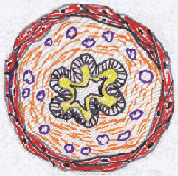WHAT IS ASTHMA?
The author, being a historian, makes no pretence to having any medical training, and so has made every effort to avoid technical subjects of a medical nature wherever possible. In addition (just to hammer down this point), he admits that he has on various occasions been caught, very red faced, making some very (medically speaking) inaccurate statements. However, the subject of actual medical cigarettes, is so important, and so misunderstood that it would be irresponsible not to dwell into it.
I for one have always thought of the lungs as a sort of, upside down tree (working in reverse), accepting oxygen and expelling carbon dioxide. The trunk being analogous the trachea or windpipe, and its branches, the bronchial tubes. The figure above sort of (with a little imagination) shows this. Note that just like the branches of a tree, the bronchia get ever so smaller and smaller the further away they are from the main trachea or central windpipe.
The next figure [below] represents a normal bronchial tube, while the figure below that represents one that is undergoing an asthmatic attack. Notice how constricted asthmatic airways are, as compared to a normal bronchial airway. This (in no small part) is caused by constricted smooth muscle and excess mucus (that liquidy stuff), which obstruct the lungs' air passages. This constriction is what causes the wheezing and breathlessness found in asthmatic patients.


These asthmatic attacks can be triggered by a number of things stress, cold weather, etc. They are usually in reaction to allergens such as pollen, cat fur, dust, molds -- almost anything airborne --- the same stuff that makes us all sneeze. The problem with asthmatics is that their bodies' natural defense mechanisms seem to overreact. Instead of just sneezing or experiencing slight irritations, the overreaction quite literally tries to choke the life out of asthma victims.
 Maybe it helps to visualize what a diagonal (cut away) view of a bronchial tube looks like. Due to the air passage running through the middle, (at least to me) it sort of resembles a donut, with oxygen flowing through the donut-hole. While blood circulates though numerous blood vessels, found within the donut or bronchial tube itself. Anyway, somehow, through the miracle of osmoses, the good stuff (oxygen) makes its way into the lung while carbon-dioxide (the bad stuff) makes it way out.
Maybe it helps to visualize what a diagonal (cut away) view of a bronchial tube looks like. Due to the air passage running through the middle, (at least to me) it sort of resembles a donut, with oxygen flowing through the donut-hole. While blood circulates though numerous blood vessels, found within the donut or bronchial tube itself. Anyway, somehow, through the miracle of osmoses, the good stuff (oxygen) makes its way into the lung while carbon-dioxide (the bad stuff) makes it way out. 
However, All this takes place ONLY if the bronchia themselves are NOT all clogged up (excess mucus) or being choked to death. Thus -- modern medicines to the rescue: And if you lived in the late 19, early 20th Century, that meant Medical Cannabis to the rescue.
But how exactly Cannabis goes about relaxing the smooth muscles within the bronchial tubes, or helps alleviate the "excess mucus" production (sometimes referred to by medical marihuana smokers today as the dry mouth effect), I do not know. Perhaps this is a subject best left for health care professionals. What is important is that if someone is suffering from an asthmatic attack, they need instant relief. They can't wait hours or even minutes before it comes.
THE CIGARETTE --As a DRUG INJECTION MECHANISM:
Perhaps the best way to understand the subject is to pretend that someone right in front of you is having a full-blown asthma attack. Normally asthmatics are suppose to take oral medications to prevent such attacks, but should one occur, most asthmatics also carry small portable steroid dispensing inhalers with them, just in case. These (fast acting) inhalers have the power to bring the medicine (usually some sort of steroid) directly right into the lungs.
However, this presumes that the asthmatic patient has access to today's modern medicines, and obviously this was not always the case. For example, inhalers did not become technically practical until after WWI, and while there were steam or vapor medical delivery devices available; (realistically speaking) how practical are they to a farmer that is plowing his field. Where is he going to get the steam etc.? As for perfume or droplets style dispensers, they are all but worthless for this purpose.
To make the matter worse, it must also be pointed out, that the "hydraulic syringe" was not even reliably available to the medical profession until the mid-1860s. And I, for one, can attest to the fact that medicines designed specifically for hypodermic syringes were not available for many decades there after.
And while orally ingested medicines were available in the 19th Century, great emphasis must be made that one of the great disadvantages of all oral medicines, is the possibly life-threatening delay (some orally ingested medicines take hours) before they begin to take effect.
Thus, cigarettes became, by default, the only practical method of delivering fast-acting medicines into the human body.
|
|
 BACK TO CHAPTER 7 |